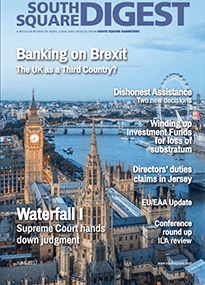

Alexander Riddiford and Robert Amey report on the recent Supreme Court decision in the long-running Lehman Waterfall litigation: The Joint Administrators of Lehman Brothers Limited (Appellant) v. Lehman Brothers International (Europe) (In Administration) and others (Respondents) [2017] UKSC 38
In September 2008, at the height of the worldwide financial crisis, various members of the Lehman Brothers group of companies entered insolvency proceedings around the world. The group’s main trading company in Europe was Lehman Brothers International (Europe) (“LBIE”). Its shares were held by LB Holdings Intermediate 2 Ltd (“LBHI2”) and Lehman Brothers Ltd (“LBL”).
LBIE and LBL entered administration in September 2008, and LBHI2 entered administration in January 2009. The administration of LBIE has two unusual features. First, LBIE has sufficient assets to pay all its external creditors. It is therefore a solvent, distributing administration. This has given rise to a number of interesting and unusual legal questions as to what should be done with the surplus remaining after payment of proved debts. Secondly, LBIE was an unlimited company (apparently for tax reasons). This has given rise to complex questions as to the rights of creditors who are also potentially liable in their capacity as shareholders.
In February 2013, the administrators of LBIE, LBL and LBHI2 issued proceedings seeking directions from the Court on a number of questions relating to the administrations, in particular the order in which various liabilities of LBIE and its administrators should be paid. As a result, this application became known as the Waterfall application (consequent applications arising out of the Waterfall application have become known as the Waterfall II and Waterfall III applications).
More than four years after the Waterfall application was issued, the Supreme Court has now handed down its judgment on the seven issues concerned.
Issue 1
Issue 1 concerned the ranking in the statutory waterfall of subordinated debt held by LBHI2. LBHI2 had advanced three subordinated loans to LBIE. Under the relevant contracts between LBHI and LBIE, the debt was expressed to be subordinated to LBIE’s other Liabilities, defined very widely as “all present and future sums, liabilities and obligations payable or owing by [LBIE] (whether actual or contingent, jointly or severally or otherwise howsoever)”.
The contracts provided that LBHI2 would have no remedy against LBIE other than as specifically provided by the contracts, and that the subordinated debt would not be paid unless LBIE was ‘solvent’ both at the time of and immediately after any payment. For these purposes, LBIE was deemed to be solvent if it was able to pay its Liabilities, disregarding “obligations which are not payable or capable of being established or determined in the Insolvency of [LBIE]”.
LBHI2 accepted that subordinated debt must therefore rank below other provable liabilities. However, it contended that it ranked above statutory interest and nonprovable liabilities. It provided two bases for this argument:
- Although non-provable liabilities are “Liabilities” under the relevant contracts, they are not “payable or capable of being established or determined in the Insolvency”. Accordingly, when determining whether LBIE was ‘solvent’ (and therefore able to pay the subordinated debt), non-provable liabilities were to be disregarded.
- Statutory interest is not “ payable or owing by [LBIE]”, since statutory interest is payable by the administrator pursuant to Rule 2.88(7) rather than by the company. Accordingly, LBHI2 argued, statutory interest was not a “Liability”, and since the subordinated debt was only subordinated to other “Liabilities” of LBIE, there was no reason for it to rank behind statutory interest. Alternatively, LBHI2 contended that statutory interest was not “payable or capable of being established or determined in the Insolvency”, for the same reasons and with the same consequences as in the case of non-provable liabilities.
The Supreme Court unanimously rejected LBHI2’s arguments. Lord Neuberger commented that it was “hard to see any satisfactory basis” for the contention that statutory interest was not payable “in the Insolvency”, since it arose as a result of (and was in fact only ever payable) in an insolvency process. On the plain wording of the contracts, statutory interest would therefore fall to be paid before the subordinated debt. Moreover, as Lord Neuberger noted, it was difficult to see any good commercial reason to construe the contracts as intending any different outcome.
Similarly, the Court rejected the argument that statutory interest did not fall within the definition of Liabilities, since it was not “payable or owing by [LBIE]”. This argument was, however, slightly stronger, since the relevant statutory provisions are expressed in terms of there being an obligation on the officeholder to pay interest out of the estate, rather than there being an obligation on the company itself. However, the Court also noted that statutory interest will often replace a contractual entitlement to interest which existed prior to the insolvency. Moreover, if it could be argued that statutory interest was not a liability of the company, but was instead an obligation imposed on the officeholder, then the same argument might be applied to provable debts. This clearly would not be right: it could not be said that a provable debt did not fall within the definition of Liabilities in the relevant contracts.
In relation to the subordination of the subordinated debt to non-provable debts, the Court held that an officeholder who paid a non-provable liability of the company was making a payment “in the Insolvency”. It did not matter that there was no express reference to non-provable liabilities in the legislation. The Court therefore found it unnecessary to resolve the difference of opinion between Moore-Bick and Briggs LJJ on the one hand and Lewison LJ on the other as to whether such liabilities were “established or determined” in the insolvency.
Lord Neuberger concluded his opinion on this issue by noting that the result the Court had reached was entirely consistent with what a reasonable reader would think upon perusing the relevant contracts. This is obviously right. Standing back from the precise language of the relevant clauses, and looking at the commercial scheme as a whole, the parties had clearly intended that the subordinated debt would indeed be subordinated to other liabilities in the event of LBIE entering administration, and it is entirely unsurprising that none of the nine judges who have looked at this in the three courts to consider the point reached a different conclusion.
Issue 2
Issue 2 concerned the rights of creditors whose debts had been denominated in a foreign currency. Under the Rule 2.86 of the Insolvency Rules, foreign currency debts are converted for the purpose of proof into sterling at the date of the commencement of the relevant insolvency process. Accordingly, creditors who were owed a debt in (say) US dollars had that debt converted into sterling as at 15 September 2008. They were then paid the sterling equivalent of those debts. However, by the time they were actually paid, sterling had depreciated against the US dollar, with the result that those creditors received considerably less than their full entitlement when converted back into US dollars as at the date of payment.
The High Court and a majority in the Court of Appeal had held that those foreign currency creditors who had suffered as a result of the depreciation of sterling between the commencement of the administration and the date of payment had a “Currency Conversion Claim” for the unpaid portion of their debt, and that such a Currency Conversion Claim ranked as a non-provable debt.
One creditor, CVI, (who stood to gain from the existence of Currency Conversion Claims) argued that the Rule 2.86 mechanism for the conversion of foreign currency debts into sterling was concerned purely with the rights of creditors among themselves. For the purpose of pari passu distribution, it is important to have a single date by reference to which all debts are valued. However, CVI argued, once all debts were paid off in full with interest, there was no reason why any shortfall to foreign currency creditors should not be made up as a non-provable liability.
LBHI2 (which, as a subordinated creditor, had an interest in keeping the value of nonprovable liabilities to a minimum) argued against the existence of Currency Conversion Claims on two bases. The primary, narrower basis, was that Rule 2.86 mandatorily converts the foreign currency debt into sterling, and renders the sterling equivalent of the debt provable in the administration, so that payment in full of the proved, sterling, sum, together with statutory interest, satisfies the claim of the creditor, who has no further claim against any surplus. The alternative, wider, basis for LBHI2’s case was that payment in full of a proved debt, as assessed in accordance with any of the provisions of the Insolvency Rules, satisfies the underlying contractual debt. Lord Neuberger, with whom Lord Kerr and Lord Reed agreed, considered that Currency Conversion Claims did not exist because rule 2.86 of the Insolvency Rules sets out in full the rights of creditors in respect of provable debts denominated in a foreign currency (LBHI2’s primary, narrower basis). Lord Sumption also agreed with this part of the majority judgment.
Lord Neuberger then went on to consider the alternative, wider basis on which LBHI2 had argued against the existence of Currency Conversion Claims. Lord Neuberger (along with Lord Kerr and Lord Reed) was inclined to the view that payment in full of a proved debt satisfies the underlying contractual debt, and where a dividend of 100p in the £ was paid on a provable debt, that debt has no component which is capable of resurrection. According to the majority, this provided an additional reason to reject the existence of Currency Conversion Claims. Lord Sumption was inclined to disagree, while noting that his opinion on this point did not assist LBIE’s foreign currency creditors, since he agreed with the majority on the primary, narrower basis for rejecting the existence of Currency Conversion Claims. Lord Clarke agreed with Lord Sumption on this point.
Lord Clarke gave a powerful dissenting judgment on Issue 2, agreeing with the majority judgments of Briggs and Moore-Bick LJJ in the Court of Appeal. His Lordship noted that although the 1986 insolvency legislation had made significant changes to the insolvency regime, it was not comprehensive, and important judge-made principles continue to be applicable. In particular, the 1986 legislation does not purport to deal with non-provable claims. Lord Clarke considered that the language of Rule 2.86, which required debts to be converted into sterling “for the purpose of proving” was simply a mechanism for calculating the amount to be paid out on a creditor’s proof, and did not affect the creditor’s underlying right to be paid the full amount of his foreign-currency claim. His Lordship concluded that it would be “wrong in principle” for shareholders to be paid, while foreign currency creditors had still not received their full contractual entitlement.
Issue 3
The next issue, Issue 3, concerned whether a creditor of LBIE who had been entitled to, but had not been paid, statutory interest under rule 2.88(7) of the Insolvency Rules 1986 (as in force at the date of LBIE’s entry into administration), can claim such interest in a subsequent liquidation.
Rule 2.88(1) provides that, when a company is in administration, creditors can only prove for contractual interest on their debts up to the date of administration, but para (7) provides for payment of interest at the rate specified in para (9) out of any surplus in the hands of the administrator, ie once all proving creditors have been paid in full. David Richards J held that, on the correct construction of rule 2.88(7), a creditor could not enforce any claim to unpaid interest under rule 2.88(7) in a subsequent liquidation. The Court of Appeal disagreed, holding that the surplus fund in the administrators’ hands was charged with the obligation under rule 2.88(7) and that this position survived the transition into liquidation.
Lord Neuberger agreed with David Richards J, holding that on the correct construction of rule 2.88(7) a creditor could not claim any unpaid statutory interest under rule 2.88(7) in a subsequent liquidation, making it clear that he also shared the Judge’s “lack of enthusiasm” in reaching that conclusion. His Lordship held (again agreeing with the Judge) that, where there was a lacuna such as this in the statutory regime, it is impermissible for the gap to be filled by some new Judge-made rule.
However, disagreeing with the Judge, Lord Neuberger concluded that the contractual right to interest for the post-administration period (to the extent that one existed) does not survive in favour of a creditor who has proved for a debt and been paid on his proof in a distributing administration.
This was because, according to Lord Neuberger, rules 2.88, 4.93 and section 189 of the Insolvency Act 1986 together provided a complete statutory code for the recovery of interest on proved debts. In particular, the decision of Giffard LJ in In re Humber Ironworks (1869) LR 4 Ch App 643, 647, on which the Judge had relied in this regard, was of no assistance in the context of this new statutory code for interest, not least because at the time of that decision (in contrast to the 1986 Rules and Act) the applicable statutory regime gave no guidance as to how contractual interest was to be dealt with in a winding up.
The remaining 4 issues, Issues 4 to 7, all arose because LBIE is an unlimited company and so its members can be called upon to make contributions under section 74 of the 1986 Act to meet its liabilities if LBIE is in liquidation.
Issue 4
Issue 4 was whether members’ contributions under section 74 can be sought in respect of the liability for statutory interest and for non-provable liabilities of LBIE.
In disagreement with the Judge and the Court of Appeal, Lord Neuberger held that a contribution could not be sought under section 74 in respect of the liability for statutory interest, in particular because: (a) statutory interest was only payable out of the “surplus” after paying proved debts in full; and (b) section 74 could not be invoked so as to create a such a surplus from which statutory interest could be paid.
The Supreme Court was referred to observations of Lord Hatherley LC and Lord Chelmsford in Webb v Whiffen (1872) LR 5 HL 711, 718 and 724, which emphasised the broad scope of the power conferred by section 38 of the 1862 Act, but Lord Neuberger considered that these could not justify interpreting section 74 in a way which was inconsistent with the wording of the rule which is said to found the basis of the particular exercise of the power. In short, Lord Neuberger considered that the contention that a surplus could be created by a call under section 74 so that statutory interest might thereby become payable was a bootstraps argument and unsound.
By contrast, Lord Neuberger agreed with the Judge and the Court of Appeal that in section 74 the word “liabilities” was not restricted to provable debts and included non-provable liabilities. Accordingly, this conclusion leads to the counterintuitive outcome that a call may be made on members under section 74 to satisfy a company’s non-provable liabilities, but cannot be made to satisfy the prior ranking liability to pay statutory interest. This outcome might make more sense if, on its proper analysis, statutory interest was not in fact the liability of the company at all, but rather the liability of the officeholder himself. Lord Neuberger speculated that this may indeed be the correct analysis, but refrained from deciding the point on the basis that it was not necessary to decide it.
Issues 5, 6 and 7
The other 3 issues arose because LBHI2 and LBL are creditors of LBIE as well as members of LBIE liable to contribute under section 74. In particular:
- Issue 5 was whether LBIE could prove in the administration of LBHI2 and of LBL in respect of their contingent liabilities to make contributions in LBIE’s prospective liquidation if they are called on to do so pursuant to section 150 of the Act.
- Issue 6 was whether, if LBIE could not so prove, it could exercise a right of set-off.
- Issue 7 was whether, if LBIE could not exercise such a right of set-off, it could invoke the so-called “contributory rule” which applies in liquidation, namely that a person cannot recover as a creditor until his liability as a contributory has been discharged.
As to issue 5 Lord Neuberger held, disagreeing with the Courts below, that the nature of the contributory’s obligation under section 150 is such that it is incapable of being the subject matter of a proof unless the company concerned is in liquidation. His Lordship held that any money paid under section 74 forms a statutory fund which can only come into existence once that company is in liquidation. Accordingly, if that company is not in liquidation there is no existing person to be identified as a potential creditor, merely a possible future liquidator. Lord Neuberger also identified various practical difficulties which would flow from an administrator being able to lodge a proof in respect of a contingent claim against a contributory which also militated in favour of his conclusion on this issue.
As to issue 6 Lord Neuberger held, for essentially the same reasons, that prospective section 150 liabilities cannot be set off by the LBIE administrators.
As to issue 7 Lord Neuberger, again disagreeing with the Courts below, held that the contributory rule – a Judge-made rule applicable to liquidators to the effect that a creditor can recover nothing from the company until his obligations as a contributory have been discharged – should be extended to distributing administrations. Lord Neuberger was plainly aware that his approach to this issue was in tension with his decisions that the 1986 legislation amounted to a “complete code” for post-insolvency interest, with there being no room for Judge made rules to fill any gaps in the statutory regime, and indeed with his rejection of the currency conversion claim. Lord Neuberger noted, at [176]: “However, in this case, the course being contemplated does not involve inventing an entirely new rule. It involves extending an existing rule so that it can apply to what is an analogous, albeit not identical, situation to that to which it previously applied, and doing so in order to achieve precisely the same end for which it was conceived.”
His Lordship concluded that the extension of the contributory rule to administrations would not conflict with the statutory regime, notwithstanding that at first sight it might seem to conflict with rule 2.69 (which requires debts to be paid in full unless the assets are insufficient to meet them) and rule 2.88(7) (which requires any surplus remaining after payment of the debts proved to be applied in paying statutory interest “before being applied for any purpose”).
Lord Neuberger’s answer to the argument that the contributory rule’s extension to administrations would conflict with the statutory regime, lay in the fact that the contributory rule undoubtedly applies in a liquidation (see per Lord Walker in Kaupthing (No 2) [2012] 1 AC 804, para [20] and per Briggs LJ in the present case [2016] Ch 50, para [243]), and yet if the argument is correct the contributory rule could not apply in a liquidation either (since similar provisions to rules 2.69 and 2.88(7) apply in a liquidation also).
Lord Neuberger also responded to the practical objections of the Courts below to the extension of the contributory rule to distributing administrations. As Briggs LJ has noted: “It would … be a serious injustice to a solvent contributory to be disabled from ever proving in a distributing administration because, in the absence of a call, there was nothing which he could pay to free himself from the shackles of the rule. The company might (and usually would) distribute all its assets to its creditors without ever going into liquidation, leaving the contributory high and dry, even though its liability as a contributory might be very small, and its claim as a creditor very large – [2016] Ch 50, para 239.”
Lord Neuberger’s answer to this objection was a practical one: “When making a distribution, the administrators should retain any sum which, if the Rule had not applied, would otherwise have been distributed to a contributory, in his capacity of a proving creditor. Thus, assuming a 100% dividend, if the administrator considers that a creditor’s reasonable maximum potential liability as a contributory, A, is greater than his proved claim, B, then B must be retained. If A is less than B, then he can be paid (B-A), and A is retained. If the dividend is not 100% (as presumably almost by definition will be the case), then the position is a little more complex. The administrator would have to assess the likely level of dividend, C, and the same exercise would have to be carried out with (C x B) rather than B. Any such exercise would inevitably be speculative, and the administrator should be cautious but realistic. Any such retention would be kept safe and ready to be paid out appropriately when the final accounts were drawn up, and (save perhaps in these unusual days) the retained money would earn interest.”
Accordingly, there can be no doubt now that the contributory rule applies to distributing administrations. However, the implementation of the contributory rule in this context is likely, in light of Lord Neuberger’s comments above, to give rise to certain practical complexities with which administrators will need to grapple carefully.
Conclusion
Although the facts of the LBIE administration are highly unusual, and some of the issues addressed in the Waterfall application are unlikely to arise ever again, the judgment does contain some dicta of general application, in particular on the question of whether the insolvency legislation is a “complete code”, and the manner in which it should be interpreted.
On one view, the insolvency regime consists of a complete legislative code supplemented in limited areas by judge-made gloss. On this view, the insolvency code must be construed literally, even if the result leads to undesirable consequences. On the opposing view, insolvency law consists of a series of fundamental principles which are expressed through (although not necessarily limited by) the legislation. On this view, the legislation is to be construed consistently with the underlying principles which it seeks to apply. The judgments in the present case fall somewhere in between the two extremes, Lord Neuberger arguably tending towards the former view, and Lord Clarke tending towards the latter.
Although the Waterfall I application has now reached its conclusion, this is not the end of the Lehman Brothers surplus litigation. The Waterfall II proceedings are currently before the Court of Appeal, and the Waterfall III proceedings are currently before the High Court.







![Brake & Anor v The Chedington Court Estate Ltd [2023] UKSC 29](https://southsquare.com/wp-content/uploads/2024/02/Brake-Anor-scaled-e1728649908896.jpeg)








